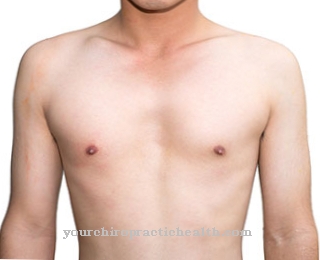The lymphatic diathesis is not a disease, but a constitutional disposition that favors the development of certain diseases. This tendency is also called Lymphatism or exudative-lymphatic diathesis designated.
What is lymphatic diathesis?
The lymphatic diathesis is a concept that is more widespread in naturopathy than in conventional medicine. Of the Lymphatism is not an independent clinical picture. It is a constitution. Formerly this predisposition was also called excessive reactions of the lymphatic system scrofula designated. The constitutional picture of lymphatism is characterized by the inability of the immune system to completely overcome infections. The focus is on repeated infections and inflammations in the area of the lymphatic organs.
causes
In modern guilty medicine, the clinical picture of lymphatism is no longer considered. In naturopathy it is assumed that the lymphatic diathesis is a hereditary problem. The constitution always describes the individual totality of all hereditary dispositions and includes all innate properties. The so-called Locus minoris resistentiae set.
This is the place of the least resistance, so to speak the weak point of the organism. In lymphatic diathesis, this weak point is in the immune system and in the area of the mucous membranes. In homeopathy, lymphatic diathesis also plays a role under the term scrofula.
Scrofula is one of the great miasms. From the perspective of homeopathy, miasms can be hereditary or acquired. The miasms cause a malfunction in the energetic-dynamic system. This leads to disturbances that show up both in this energetic system and on a physical level.
Symptoms, ailments & signs

© Sebastian Kaulitzki - stock.adobe.com
Lymphatic diathesis develops in the first months of life and usually ends with the onset of puberty. Initially, the lymphatism in infants shows up, for example, in the form of cradle cap, weeping skin inflammation or diaper eczema. Small children, on the other hand, suffer from dry eczema, urticaria or neurodermatitis.
Recurring inflammations of the mucous membranes and the lymphatic organs are characteristic of lymphatic diathesis. The children often have colds. Tonsillitis occurs again and again. In addition, the little patients complain of earache. The appendix is also a lymphatic organ. Children with lymphatic diathesis are more likely to show irritation of the appendix. There may also be inflammation of the appendix. In such cases, the appendix must then be removed.
Sometimes the children are sick so often that their development is disturbed by it. They learn to speak or walk later than other children and are often absent from school or kindergarten.Children's immune systems are generally very active. Even in healthy children, swelling of the lymphatic organs often occurs. In lymphatic children, however, this activity exceeds the normal level. This is evident from constant swelling of the tonsils, irritation of the appendix or also from swelling of the spleen.
The lymph nodes in the neck area are enlarged and sensitive to pressure even without an ongoing infection. The nasal polyps are also enlarged, the nose is often blocked. This hinders nasal breathing, so that mouth breathing occurs. Secretion builds up as a result of otitis media and effusions of the tympanic cavity. Because of this, sinus infections often occur.
For normal dentition and jaw development, it is important that the children breathe primarily through their noses. Due to the constantly blocked nose, children with lymphatic diathesis breathe more through the mouth. The result is misaligned teeth and jaws.
Diagnosis & course of disease
The diagnosis of lymphatic diathesis is largely based on the patient's medical history. A tendency to diseases of the lymphatic system can be determined here. Children with a lymphatic constitution are also more likely to be pale, blond-haired and blue-eyed. Thus, the appearance can also provide clues to the diathesis.
Iris diagnostics is a naturopathic procedure that can be used to diagnose diseases based on the eyes. With this, too, the lymphatic diathesis can be recognized. People with lymphatic diathesis usually have blue eyes with a light-colored ring around the colon. This bright ring is located in the lymphatic zone. However, the iris diagnosis is not a scientifically recognized procedure.
Complications
As a rule, with this disease, patients suffer from various ailments and diseases of the skin. This mainly leads to inflammation and the development of itching. It is not uncommon for those affected to be ashamed of the symptoms and suffer from reduced self-esteem or inferiority complexes.
Likewise, tonsillitis or inflammation in the ears can sometimes occur. These are usually associated with severe ear pain that can also spread to the head or neck. The disease also leads to appendicitis, in which the appendix must eventually be removed.
People may also have sinus infections, which significantly reduces the patient's quality of life. In some cases, the affected person's jaw and teeth can also be incorrectly developed, leading to discomfort when eating and drinking. Treatment is usually carried out through various interventions and by taking medication. In this way, inflammation and malpositions can be combated and alleviated relatively well.
When should you go to the doctor?
The lymphatic diathesis can cause a number of diseases and complaints, which is why an early diagnosis is useful. Parents who notice signs of such a predisposition in their child should look out for other warning signs and, if necessary, consult their pediatrician. The doctor must be involved at the latest when respiratory problems, skin changes, unspecific pain and other typical signs of a sympathetic disease occur. Recurring inflammation, swollen lymph nodes in the neck area and headache or earache must be clarified immediately.
The same applies to diseases of the appendix, gastrointestinal complaints and signs of an organ disorder. If the child is treated early, further complications can be excluded. For this reason, a medical diagnosis must be made as soon as the first symptoms appear. The treatment is carried out by the family doctor, an internist or a lymphologist. In addition, depending on the clinical picture, dermatologists, gastroenterologists, ENT specialists and ear specialists are called in. The actual therapy takes place either in a specialist clinic or in a doctor's office, depending on the severity of the disease. Slightly pronounced disorders can possibly be treated naturopathically.
Therapy & Treatment
From a naturopathic point of view, the immune system should be supported in patients with lymphatic diathesis. Various phytotherapeutic agents, such as the coneflower or the coneflower (Echinacea) have an immune-stimulating and immunomodulating effect. Plants such as marshmallow root, mullein, coltsfoot or wild mallow can be used for infections of the upper respiratory tract.
Typical single remedies in classical homeopathy are Calcium carbonicum, Tuberculinum, Psorinum, Scrophularia nodosa or Kalium sulfuricum. An essential part of the human immune system resides in the gut. A disturbed intestinal flora can weaken the immune system. With the help of probiotics, the intestinal flora of the patient should be built up and modified if necessary. This intestinal rehabilitation is often supplemented with a so-called drainage therapy.
In naturopathy, it is assumed that metabolic end products are deposited in various tissues of the body in the course of life and hinder the metabolic processes taking place there. Often there is talk of slag. The aim of diversion therapy is to rid the body of these waste products. Excretory organs such as the kidneys, liver and skin are supported with complex homeopathic or herbal medicinal products.
Nettle and goldenrod, for example, support the kidneys, milk thistle and dandelion have a positive effect on liver function. From a scientific point of view, however, there is no indication for diversion. The avoidance of cow's milk, which is recommended by many therapists for lymphatic diathesis, is also controversial.
You can find your medication here
➔ Medicines to strengthen the defense and immune systemOutlook & forecast
It is not possible to make a prognosis for lymphatic diathesis because it is not an independent disease. Rather, it is a human disposition that favors the development of certain other diseases. It can therefore be determined in principle that people whose genetics are predisposed to lymphatic diathesis will not experience any change in the likelihood of the development of diseases.
Nevertheless, it is not possible to predict the extent to which certain diseases will actually break out in the course of life. There are patients who have lymphatic diathesis, but show no significant impairment in the course of their lives. In other people, however, there are severe health problems and a reduction in quality of life.
The development of various inflammatory diseases can lead to a reduction in wellbeing. However, it is not possible to predict how often this inflammation will occur and what intensity it will show. With a good and stable lifestyle, the symptoms appear in a milder form. If the person concerned avoids the consumption of harmful substances and if he or she orientates himself towards a health-conscious lifestyle, symptoms are often alleviated. Nevertheless, despite all efforts, an intense occurrence of the sequelae can be documented in a large number of patients. Developmental delays occur in the growth process and the number of diseases is increased on average due to the genetic disposition.
prevention
Lymphatic diathesis is innate, so there are no means of preventing it. With a known lymphatic diathesis, however, the body can be specifically supported. In this way, secondary diseases can possibly be avoided.
Aftercare
The follow-up measures for a skin disease such as lymphatic diathesis depend heavily on the severity of the disease, so that generally no general prediction can be made. First and foremost, those affected should be examined by a doctor so that there are no further complications or complaints. The earlier this disease is recognized and treated, the better the further course.
Since some skin diseases are contagious, contact with other people should be avoided. A high standard of hygiene can also have a positive effect on the course of the disease and reduce the symptoms. In most cases, these diseases are treated with the use of creams or ointments and medication.
Those affected should ensure regular use and the correct dosage in order to permanently alleviate the symptoms. Regular checks by a doctor are very important. In most cases, lymphatic diathesis does not have a negative impact on the life expectancy of those affected. Contact with other patients can also be useful in order to exchange ideas about healing methods.
You can do that yourself
A lymphatic diathesis should always be clarified by a doctor. In addition to medical treatment, those affected can alleviate the symptoms with the help of some natural medicine. For example, various phytotherapeutic agents such as coneflower and capelargonium have proven themselves. Plants such as marshmallow root or coltsfoot also have a stimulating effect on the immune system. Mullein and arnica help with infections of the upper respiratory tract.
In addition, homeopathy offers a number of individual remedies, including Calcium carbonicum and Kalium sulfuricum. In addition, probiotics can be used because they protect the intestinal flora and help with complaints. Other effective plants are nettle, goldenrod and milk thistle. The use of these funds should be discussed beforehand with the responsible doctor.
It is also important to determine the cause of the lymphatic diathesis. Depending on the trigger, various measures are then useful. In general, a change in lifestyle is advisable. A strengthened immune system is less susceptible to illness and ensures better well-being. In addition, care must be taken to ensure a healthy and balanced diet that supports the medical therapy measures.


.jpg)

.jpg)



















.jpg)



